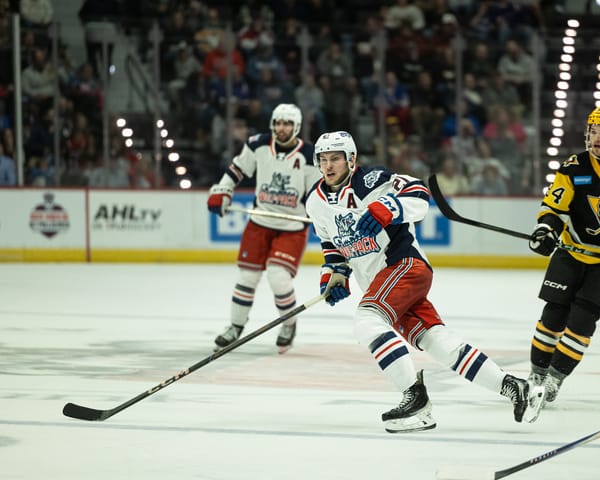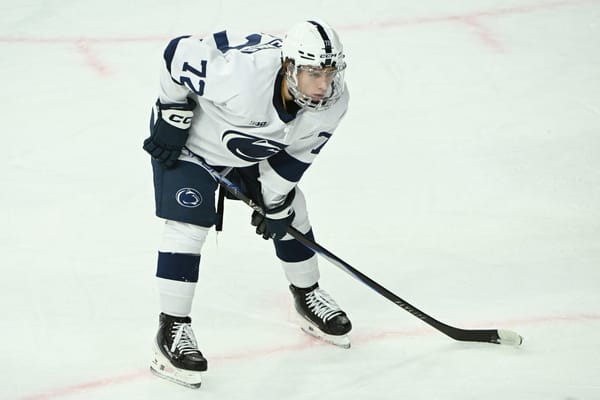Summer 2017 New York Rangers Prospect Rankings: 29-25
29. Sergey Zborovskiy, Defenseman, 20 Years Old, Third-Round Pick (2015)
Previous Rank: 28
At face value, it appears that Zborovskiy improved significantly this past season. He produced 40 points in 63 WHL games after hitting only 25 the year before. In particular, he improved his assist total by 16. Big jump, right?
As always, context is key. Zborovskiy played for the Regina Pats, who were far and away the best offensive team in the CHL last season. More specifically, answers lie in Zborovskiy’s usage. Regina had Adam Brooks and Sam Steel leading their offense, and both were first and second respectively in the WHL in points-per-game. I spoke to an NHL employee who works in prospect evaluation. What he told me was that, as of January 1st, Zborovskiy spent about 70% of his even strength shifts with those two on the ice. In fact, according to the source, no player in the entire WHL had a higher Quality of Teammate rating than Zborovskiy at that time.
It’s not hard, then, to diagnose the reason for Zborovskiy’s massive jump in assists. Give the puck to the two best players in the WHL and let them do the rest. In fact, just 15 of Zborovskiy’s 33 assists were primary assists. Among WHL defensemen, Zborovskiy ranked 28th in primary points (goals plus primary assists). Zborovskiy was only third among Regina’s defensemen in scoring, and it’s not as if the two ahead of him (Connor Hobbs and Chase Harrison) are stud prospects. A rising tide lifts all boats.
No doubt Zborovskiy improved from last season, but overall he’s still a relatively poor skater who struggles at successfully moving the puck out of the defensive zone; something that should give every Ranger fan nightmares by now. At the World Juniors, he looked particularly exposed with the talent around him neutralized. The bubble burst on him in the second half of the season. Including playoffs, he had just one goal and 16 assists in his final 61 games. Miserable production for a 19/20-year-old on a stacked team. He is good on board battles and his long reach makes him a solid penalty killer, but that’s not enough to cover for all of the deficiencies. For an outside perspective, I spoke to a scout in Western Canada. He did not disagree with my evaluation.
“There is improvement there two years later but he's surely a major product of how good (Regina) is… he's just not a guy who I think has any long-term (NHL) career.”
28. Patrik Virta, Forward, 21 Years Old, Seventh-Round Pick (2017)
Previous Rank: N/A
Seventh-round picks are the longest of long shots. If you’re going to find a diamond in the rough, then chances are it will either be a goaltender or an undersized point producer.
Virta fits the mold of undersized (5’10, 181 lbs) point producer. He was a constant source of offense in junior leagues in Finland. Last season, in his sophomore season at Finland’s top level, he produced 14 goals and 12 assists in 49 games. Then, he scored five goals in six playoff games. Pretty solid numbers for a 20-year-old. Our European hockey informant, Alex Nunn, put together some great footage of Virta.
Some footage of #NYR seventh-round pick Patrik Virta. Has great wheels and loves to shoot the puck. pic.twitter.com/bGFzqRozsx
— Alex Nunn (@aj_ranger) June 24, 2017
Liiga publicly posts basic advanced statistics on its website. Virta was 59.7% in Corsi last season, which was fifth-best among all forwards in the entire league. The data lacks context such as usage, linemates, and overall team strength. Still, it’s a piece of the puzzle and reflects well on his ability to drive play.
It appears that Virta will play for TPS again next season. Should he have another year of increased offensive output, one would expect the Rangers to sign him and bring him over to the AHL for 2018-2019.
27. Morgan Barron, Center, 18 Years Old, Sixth-Round Pick (2017)
Previous Rank: N/A
My first impression of the Rangers’ selection of Barron was not a good one. Playing high school hockey in Canada, Barron played his pre-draft year at an extremely low level (relative to other NHL draftees). Scouting reports I read on him were not inspiring and painted him as a big, strong (6’3, 210 lbs) center who couldn’t skate well and had no hockey IQ. There’s nothing I hate more than when teams draft slow, dopey players just because they happen to have size. I was concerned that this was all Barron amounted to.
But after watching him play, I realized there was definitely more to him than that. He needs a ton of work on his acceleration, but once he’s built up speed his long strides get him moving. He’s confident carrying the puck through the neutral zone. He uses his body well to shield the puck. Of course, he is commanding along the walls and in the slot. His shot is heavy, though there’s room to improve the efficiency of his shooting motion. With apologies for the video quality, here are some clips of Barron (wearing #20 in white) that I put together.
Barron is the definition of a project pick. He’ll be at Cornell playing against men for the next four years, which is absolutely the right decision. He’s extremely raw but has a lot of tools. He’ll have plenty of time to grow his game against older competition without any immediate pressure of earning a contract. The hope is that he’ll come out the other side of that as a hockey player. If the stars align, he has a chance to be an imposing player at the NHL level.
26. Brandon Crawley, Defenseman, 20 Years Old, Fourth-Round Pick (2017)
Previous Rank: N/A
Like with Barron, my opinion on Crawley now is not exactly the same as my first impression. This past season, including playoffs, he had seven goals and 24 assists in 75 games; mediocre numbers for a 19-year-old on a contending team. My guess is that statistical projection models wouldn’t view Crawley favorably in the slightest. Scouting reports on Crawley paint him as a shutdown defenseman, which is nice in theory but is often code for a player who concedes the blue line and gets pinned in his own zone.
However, I reached out to a forward-thinking OHL mind, and he defended the pick to a degree. In regards to the lack of offensive production, it perhaps is partly a product of his environment. The London Knights, for all of their success, aren’t known for developing offensive defensemen. Head Coach Dale Hunter wants his defensemen to simply move the puck up the ice and let the forwards do the rest. With a few exceptions, the defense isn’t even very involved in controlled offensive zone possessions.
“Crawley, on a different team, could probably put up better numbers,” I was told.
I watched some London games from last season. Here is some of what I saw from Crawley (wearing #14 in white/green).
He is a smart defensive player. His gap control and spacing are good. His outside shoulder is always lined up with the forward’s inside shoulder, as is taught. He clears out the slot and lets his goalie see shots. He does a fantastic job of tying up passing options in the slot. His passing is nothing special but he makes a solid first pass from within the defensive zone; no panic. He has good defensive zone awareness, but as one of those clips showed his lack of mobility can sometimes cause him to lose his man.
Crawley is going to be a solid professional hockey player, but I am concerned that his skating - which is merely average at best - and lack of offensive influence could limit him to the AHL. As it was put to me, Crawley was “not the best pick, but not a bad one.” For me, the fourth round was two rounds too early to take Crawley. Nonetheless, what’s done is done. He’s a solid prospect with upside as a shutdown defenseman in the NHL.
Crawley is very ripe and should not have too hard of a time transitioning to pro hockey. How the Rangers deal with their logjam on defense at the NHL level will create a domino effect throughout the entire organization, so it’s tough right now to predict where Crawley starts the season. I think he is ready for a third-pairing spot in the AHL. However, if there’s not one to offer him, then he could start the season either in the ECHL with the Greenville Swamp Rabbits or go back to London for an overage season.
25. Vince Pedrie, Defenseman, 23 Years Old, Free-Agent Signing (2017)
Previous Rank: N/A
The Rangers were quick to nab Pedrie after his junior season at Penn State ended. He scored eight goals and added 22 assists in 39 games, and was an influential figure in what became an iconic season for Penn State hockey. They earned a spot in the NCAA tournament for the first time ever.
Of the handful of free agent signings the Rangers sent to the AHL for the end of the 16-17 season, Pedrie was the one with the biggest impact. In nine games for Hartford, he was a needed injection of offense from the blue line. His style of play is very direct. When he gets the puck, he’s immediately looking for a shooting lane. If it’s not there, he’s moving the puck elsewhere.
Again, he’s always looking to shoot. In those nine games, he had 23 shots total. That was not an aberration. He led all NCAA defensemen in shots on goal during the 2016-2017 season, with 167 (in 39 games). In fact, only two NCAA forwards had more shots than he did. Of course, his shooting prowess makes him an asset on the power play. Though he didn’t actually score with the Wolf Pack, he did generate a lot of second chances with those shots, tallying five assists in nine AHL games. His defensive game needs improvement all over the place, but particularly in man-to-man zone coverages. His offense is not so exceptional that defensive deficiencies can be overlooked. Fixing that will be the big focus for him in his first full season in Hartford.




